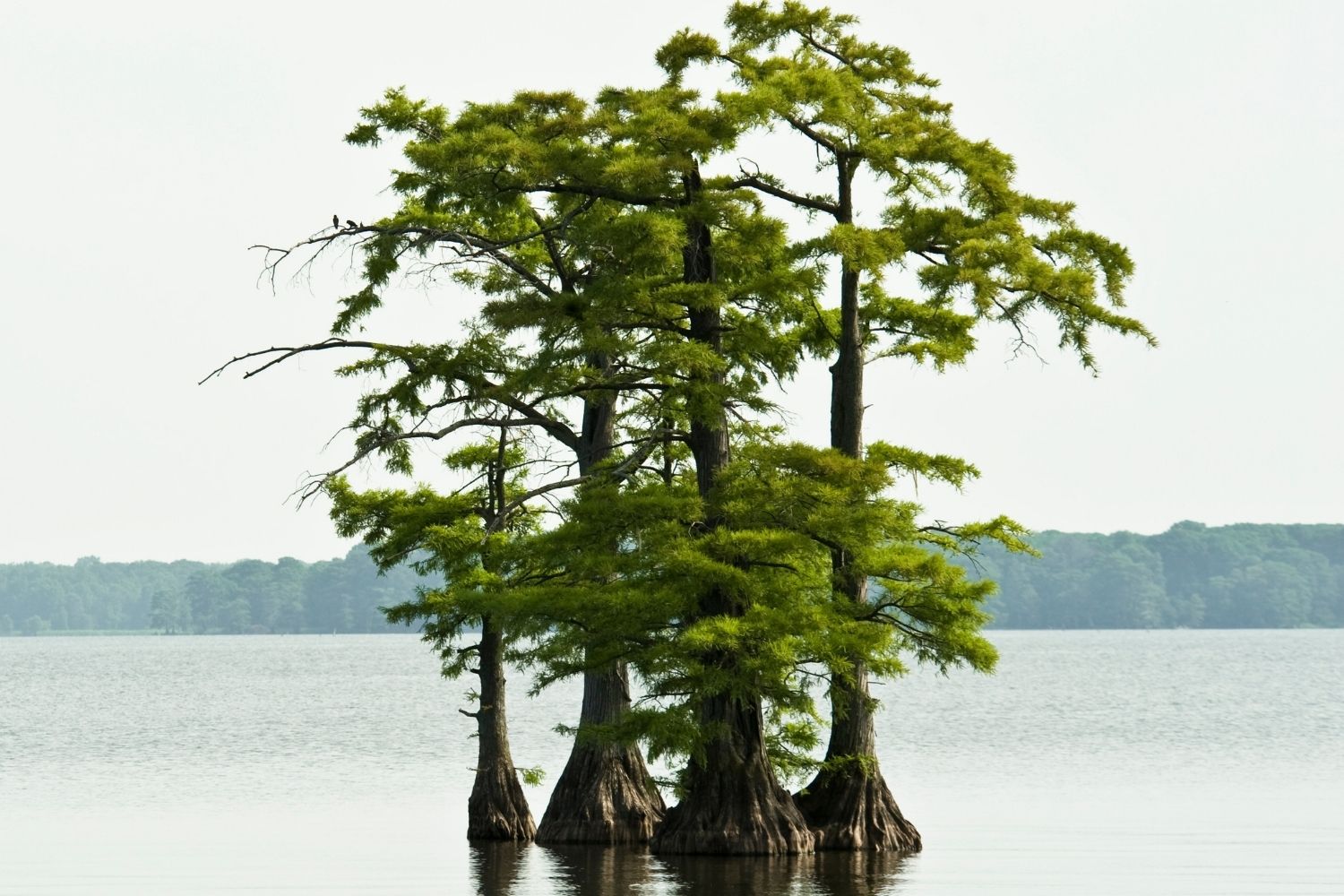This stately conifer, native to the Midwest, is often found in groupings in parks and larger spaces, along streets, and around lakes. Unlike most cone-bearing trees, bald-cypress loses its needles each winter and grows a new set in spring. The russet-red fall color of its lacy needles is one of its outstanding characteristics. Hardy and tough, this tree will adapt to a wide range of soil types, whether wet, dry, or swampy.
The bald cypress tree (Taxodium distichum) is a deciduous conifer native to the southeastern United States. With its graceful form and attractive foliage, this iconic tree has fascinated people for centuries. In this article, we’ll explore the origins and natural history of the bald cypress and how it has been used by humans over time.
Native Range and Habitat
The bald cypress is native to the southeastern United States, spanning from Delaware down to Texas and inland up the Mississippi River drainage basin. Its native habitat is the swamps and wetlands of the southeastern coastal plain.
Bald cypresses thrive in wet conditions along riverbanks, backwater swamps, marshes and other riparian areas. They are well-adapted to flooded soils and can grow in standing water. In fact, their root systems require wet conditions to develop properly. The knobby projections called “knees” that emerge from the roots are thought to help provide oxygen to the roots in waterlogged swampy soils.
Natural History and Ecology
Bald cypresses are very long-lived trees with life spans over 1000 years. Some of the oldest specimens are over 1,500 years old, making them some of the oldest non-clonal trees in Eastern North America.
These trees play an important ecological role in wetland ecosystems of the southeast. Their wide buttressed trunks help stabilize shorelines and reduce erosion. When bald cypresses shed their needles in the fall the decaying foliage provides nutrients for aquatic organisms. The hollow trunks, knees and buttresses of older trees also provide habitat for wildlife including nesting sites for birds and waterfowl.
Bald cypresses have a few natural predators, such as the cypress bark beetle and bald cypress leafroller. But they are resistant to damage from flooding, storm winds and even fire thanks to their thick bark. Their longevity is due to these natural defenses.
Early Human Uses
Native Americans have utilized bald cypress trees since prehistoric times. The water-resistant wood was used to make canoes houses ceremonial objects and other items. Native Americans like the Choctaw also harvested bald cypress bark to make rope and string.
When early European settlers arrived in North America in the 1700s and 1800s, they quickly recognized the valuable properties of bald cypress wood. The harvest of these trees escalated to support growing colonial towns and the logging industry.
Bald cypress wood was prized for its strength, resistance to rot and insect damage, and workability. The heartwood, called “pecky cypress”, was used to build fences, barns, railroad ties, ships and more. Lumber companies heavily logged bald cypresses through the early 1900s until most old-growth forests were depleted.
Modern Uses
Today, bald cypresses are still valued as timber but modern forestry practices focus on more sustainable selective harvesting. They are also widely planted ornamentally, especially the cultivar ‘Pendens’ which has a weeping growth habit.
Bald cypresses make excellent landscape trees thanks to their distinctive look, environmental tolerance and fast growth rate. They thrive on lake edges and in wet spots or rain gardens. In the fall, the feathery green needles turn orange-brown before dropping, providing great seasonal color.
Wetland conservation and restoration projects across the southern U.S. commonly plant bald cypress to reestablish these important ecosystems. The trees help filter pollutants, reduce flooding, and provide habitat for wetland species. Their return is bringing back the iconic beauty of southern swamps.
So next time you see a majestic bald cypress, consider the long and valued history of this fascinating tree, one of the true giants of southern wetlands. From ancient cypress swamps to modern backyards, the bald cypress continues beautifying landscapes across the southeastern United States.

Darkhn1 Bald-cypress (52-2009* is in the Alnus
East Side and West Side
Find on the Map
Enter keywords to search on the arboretum map.
Bald Cyprus Tree- Taxodium distichum – Growing Bald Cypress
FAQ
Where did the bald cypress come from?
Where are bald cypress trees native to?
Where did cypress originate from?
What are the negatives of bald cypress?
What is a bald cypress tree?
( L.) Rich. Taxodium distichum ( baldcypress, bald-cypress, bald cypress, swamp cypress; French: cyprès chauve ; cipre in Louisiana) is a deciduous conifer in the family Cupressaceae. It is native to the southeastern United States. Hardy and tough, this tree adapts to a wide range of soil types, whether wet, salty, dry, or swampy.
Where did bald cypress trees come from?
Ancient bald cypress forests, with some trees more than 1,700 years old, once dominated swamps in the Southeast. The original range had been thought to only reach as far north as Delaware, but researchers have now found a natural forest on the Cape May Peninsula in southern New Jersey.
How old is a baldcypress tree?
The iconic “Caddo Lake Cypress” in Texas is one of the oldest living Baldcypress trees, estimated to be around 1,500 years old. Baldcypress trees are considered “conifers” due to their cone-bearing reproductive structures, despite shedding their leaves like deciduous trees.
How do bald cypress trees grow?
The bald cypress grows in full sunlight to partial shade. This species grows best in wet or well-drained soil but can tolerate dry soil. It is moderately able to grow in aerosols of salt water. It does well in acid, neutral and alkaline soils across the full range of light (sandy), medium (loamy), and heavy (clay) soils.
